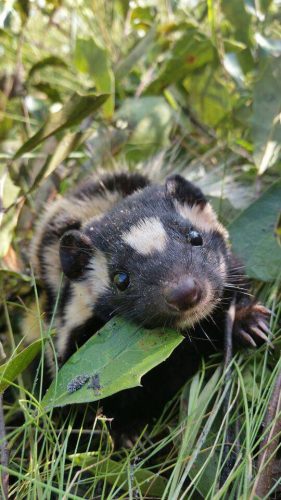The Eastern Spotted Skunk (Spilogale putorius) is native to Florida but is the least studied Florida species. It was thought that they were abundant throughout Florida except in the Keys. This is a small skunk, about the size of a squirrel, has a weasel-shaped body. Eastern spotted skunks have various areas of white on the body that mix with the black and vary on each individual. They have short legs and are slow-moving. The spotted skunk is omnivorous and enjoys dining on plants, berries, nuts, fruits, rodents, frogs, snakes, small lizards, and bird eggs.
Eastern Spotted Skunks are nest predators of ground-nesting birds. Unfortunately, the critically endangered Florida Grasshopper Sparrow is among the skunk’s prey.
A female spotted skunk will create a den in a tree hollow, gopher tortoise burrow, or abandoned structure. Her litter will range between 2 to 10 kits each year. At 4 weeks, the young go out looking for food with their mother and are weaned at 8 weeks. By 4 months, they are adults and leave the den. The life span of the spotted skunk is 1 to 2 years.
Like all skunks, the Spotted Skunk has well-developed anal glands that emit musk, if they are threatened. These glands contain a “nipple” that allows the skunk to aim its spray accurately. The spotted skunk is noted for its characteristic “handstand” stance that it takes when threatened. Before spraying its opponent, the skunk raises its front legs and turns its head to watch as it sprays.
The Spotted Skunk is the only member of the skunk family that can climb. Their predators include humans, dogs, cats, bobcats, coyotes, foxes, and owls.
The population of eastern spotted skunks has not been well-studied. Loss of habitat, insecticide use, and predators may indicate they are not as abundant as once thought.
photo credit FWC.

